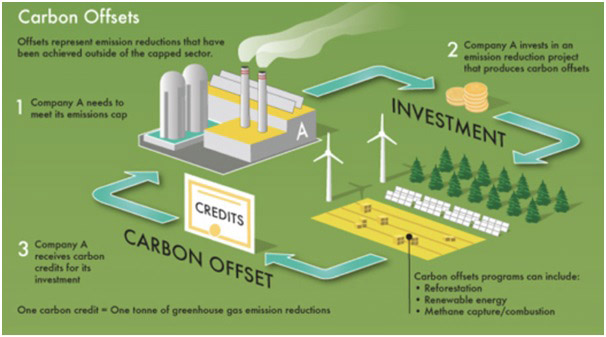ArcPacific formed the wholly owned subsidiary, ACP Carbon Corp. to explore business opportunities in the voluntary carbon offset credit market. Such opportunities exist within the Canadian landscape that are closely related to the natural resource sector. The Company sees the voluntary carbon offset credit market as a rapidly evolving space, which may avail opportunities for ACP to form complementary partnerships and develop business models to take part in the monetization of such credits.
What is an offset?
An offset is a tradable credit that is used to counterbalance – or offset – greenhouse gas emissions. Typically, an Offset Unit represents a tonne of carbon dioxide equivalent that was either removed from the atmosphere or not released into the atmosphere as the result of direct, beyond business-as-usual action by a project proponent. These actions are validated and verified by an independent, accredited third-party to ensure they are real, permanent and additional.
The Carbon Offset Credit Market
Carbon Credits with Trey Lockerbie
Carbon Credits: The Most Misunderstood Commodity

Eight Steps to Net Zero
8 steps Canada can take right now to get us to a net-zero-emission economy
Source: https://www.corporateknights.com/climate-and-carbon/8-steps-canada-can-take-right-now-to-get-us-to-a-net-zero-emission-economy/
Now that the UN’s 26th climate conference has come to a close, Canada needs to turn its attention to chopping our emissions in a hurry. As of June, Canada’s target of reaching net-zero emissions by 2050 is cemented in law. The federal government committed to slashing emissions by 40 to 45% below 2005 levels within eight years. Now government and industry leaders need to work together to ramp up their urgency and ambition. Here are some ideas on how we can get there.
1. Mandate that all new cars be electric by 2030 (not 2035)
And offer 100% rebates to homeowners and workplaces that install electric vehicle chargers, while building at least 10 times more public charging stations across the country.
2. Close the carbon-tax loopholes for the largest polluters
Canada’s biggest CO2 emitters pay next to no carbon tax. That needs to change if we want the carbon tax to be effective at driving down emissions.
3. Inject $20 billion into renewable energy storage
The federal government may be phasing out coal by 2030, but there’s a lot more it can do to scale up a clean grid. To avoid the green energy shortfalls now facing Europe, we’ll need major investments in renewable energy storage over the next 10 years.
4. Require provinces to ensure that all new buildings are natural gas-free
The federal government should require provinces that receive support from the Canada Mortgage and Housing Corporation to ban gas in new buildings, and could provide 100% zero-interest financing for deep retrofits and electric heat pumps in existing buildings.
5. Get pension funds and banks to invest in line with Canada’s net-zero plan
Huge pools of private capital must be harnessed to finance the clean transition. Let’s use the Income Tax Act to require tax-subsidized pension plans to invest in ways that are consistent with Canada’s net-zero carbon goal, and also link the Bank of Canada interest rate to whether a commercial bank’s loan book jives with that net-zero goal.
6. Help workers retrain for the clean economy
A just transition to a cleaner economy means ensuring that no workers are left behind. A Denmark-style annual stipend of $50,000 could help those in polluting industries secure jobs in the low-carbon economy.
7. Grow nature-based climate solutions
Foresters agree we can upgrade Canada’s tree-planting target from 1.6 billion to 16 billion by 2030 in a way that increases resilience against forest fires. Growing existing forests by 30% by “rewilding” landscapes is also key, combined with protecting remaining old-growth forests and other carbon-dense ecosystems.
8. Slash synthetic fertilizer use and support carbon farming
Canada spends less than $2 per acre per year on climate-related farm programs. In addition to firming up national targets to cut nitrogen fertilizer (which emit potent GHGs) use by 30%, the federal government should increase farm subsidies to encourage the use of regenerative methods to store more carbon in the ground.
Other Market Opportunities
Blue Carbon Article
The Globe and Mail: Endangered Underwater Ecosystem
- Seagrass, mangroves and salt marshes – known collectively as “blue carbon” – are highly efficient carbon sinks
- Seagrasses are able to absorb carbon an estimated 35 times faster than forests on land
Disclaimer
There can be no assurance that there will be business opportunities within the voluntary carbon offset credit market or that the Company will pursue business opportunities within the voluntary carbon offset credit market that will result in a transaction or other strategic change or outcome. The Company has not set a timetable for the conclusion of its review, and it does not intend to comment further unless and until ACP’s Board of Directors have approved a specific course of action or the Company has otherwise determined that further disclosure is appropriate or required by law.
